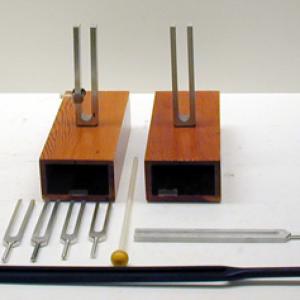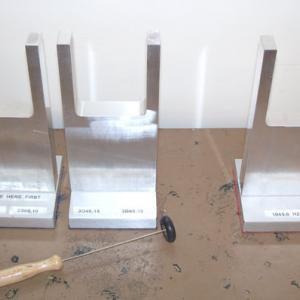College of Liberal Arts & Sciences
3D46.15 - Tuning Forks - Various
All the tuning forks need to be coated with WD-40 at least 3 times a year to prevent rusting. To remove rust make a .1 Molar solution of Ammonium Citrate and let the metal parts soak in this for several hours. Rinse with vigorous scrubbing under running water, dry and oil immediately. DO NOT scrape or rub the forks with any abrasive materials as this will change the pitch and vibration of the fork. Broken boxes need to be re-glued with special glues to preserve their resonance properties.
The "motor mount" style tuning forks are particularly good for large classrooms.
- Robert Drosd, Leonid Minkin, and Alexander S. Shapovalov, "Interference and the Law of Energy Conservation", TPT, Vol. 52, #7, Oct. 2014, p. 428.
- James Lincoln, "Ten Things You Should Do With a Tuning Fork", TPT, Vol. 51, #3, Mar. 2013, p. 176.
- Thomas B. Greenslade Jr., "Acoustic Resonators", TPT, Vol. 50, #8, Nov. 2012, p. 485.
- Jeffrey D. Goldader, "Determining Absolute Zero Using a Tuning Fork", TPT, Vol. 46, #4, Apr. 2008, p. 206.
- John D. McGervey, "Hands-on Physics For Less Than a Dollar Per Hand-Part III", TPT, Vol. 34, #7, Oct. 1996, p. 448.
- Howard Brody, "Radar Guns and Tuning Forks", TPT, Vol. 30, #2, Feb. 1992, p. 102.
- Thomas B. Greenslade, Jr., "The Acoustical Apparatus of Rudolph Koenig", TPT, Vol. 30, #9, Dec. 1992, p. 518.
- Thomas B. Greenslade, Jr., "Photo - Koenig's Tonometer", AJP, Vol. 76, #7, July 2008, p. 670.
- Iain G. Main, "The Use of a Moving-Coil Galvanometer to Demonstrate Free and Forced Vibrations", AJP, Vol. 56, #9, Sept. 1988, p. 839.
- R. M. Sillitto, "Angular Distribution of the Acoustic Radiation from a Tuning Fork", AJP, Vol. 34, #8, Aug. 1966, p. 639.
- Sf-1, 2, Sh-4, Sc-3: Freier and Anderson, A Demonstration Handbook for Physics.
- W-265: "Tuning Fork and Tuned Cavity", DICK and RAE Physics Demo Notebook.
- M-945: "Tuning Fork on Sounding Board", DICK and RAE Physics Demo Notebook.
- Shoma Kutasov, "Interference of the Sound of a Tuning Fork", Physics Demonstrations, p. 227.
- "Scientific Pitch Notation", Wikipedia, https://en.wikipedia.org/wiki/Scientific_pitch_notation.
- Joseph Frick, "#148 - The Tuning-Fork", Physical Technics: Or, Practical Instructions for Making Experiments in Physics and the Construction of Physical Apparatus with the Most Limited Means", p. 175.
- The Queen Catalogues Vol. II, Catalogue of Physicsal Instruments, No. 4572, p. 44.
Disclaimer: These demonstrations are provided only for illustrative use by persons affiliated with The University of Iowa and only under the direction of a trained instructor or physicist. The University of Iowa is not responsible for demonstrations performed by those using their own equipment or who choose to use this reference material for their own purpose. The demonstrations included here are within the public domain and can be found in materials contained in libraries, bookstores, and through electronic sources. Performing all or any portion of any of these demonstrations, with or without revisions not depicted here entails inherent risks. These risks include, without limitation, bodily injury (and possibly death), including risks to health that may be temporary or permanent and that may exacerbate a pre-existing medical condition; and property loss or damage. Anyone performing any part of these demonstrations, even with revisions, knowingly and voluntarily assumes all risks associated with them.


